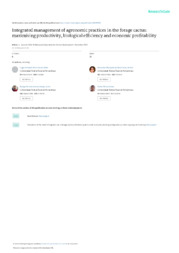Integrated management of agronomic practices in the forage cactus: maximizing productivity, biological efficiency and economic profitability.
Integrated management of agronomic practices in the forage cactus: maximizing productivity, biological efficiency and economic profitability.
Author(s): ALVES, H. K. M. N.; JARDIM, A. M. da R. F.; SOUZA, L. S. B. de; ARAÚJO JÚNIOR, G. do N.; ALVES, C. P.; ARAUJO, G. G. L. de; STEIDLE NETO, A. J.; SALVADOR, K. R. da S.; PINHEIRO, A. G.; SILVA, T. G. F. da
Summary: Forage cactus cropping systems that include a combination of agricultural practices (cloning, irrigation, mulching, and/or intercropping) can increase forage production and economic return in semi-arid environments. This study evaluated the effect on productivity, biological efficiency, and economic return of combining different practices with forage cactus cropping systems in the semi-arid region of Brazil. The research was conducted in four experimental areas, in a randomized block design with four replications, and included the following practices: 1) clones – irrigation - cover, 2) different irrigation depths, 3) intercropping - mulching, and 4) different levels of mulch. The treatments in experiment I consisted of three cactus clones (‘Orelha de Elefante Mexicana’—OEM; ‘Miúda’—MIU and ‘IPA-Sertânia’—IPA), two water regimes (rainfed and irrigated), and two levels of mulch (with and without mulch). Experiment II comprised four irrigation depths (0, 40, 80, and 120% of the crop evapotranspiration) and three cactus clones. In experiment III, three crop arrangements (single cactus, cactus intercropped with millet, and single millet) were evaluated under two levels of mulching (with and without mulching). In experiment IV, four levels of mulch were used (0, 5, 10, and 15 Mg ha-1). The total number of cladodes per plant, fresh matter yield (YFM), dry matter yield (YDM), and final plant density were obtained when harvesting. Economic viability was assessed using the profitability index (PI). The rainfed systems showed greater yield. The use of mulch afforded greater productivity. The OEM clone (YFM = 310.76 Mg ha-1 and YDM = 29.87 Mg ha-1) obtained a higher yield than did the IPA and MIU clones. The highest PI values were achieved under the rainfed systems. The MIU and IPA clones exhibited lower PI values. The cactus-millet intercrop achieved the best performance with the use of mulch. Cactus systems of 15.0 Mg ha-1 showed a greater PI value. It was concluded that the integrated management of such practices as intercropping, mulching, and the adoption of the OEM clone can increase the supply of forage. These practices can promote the sustainable intensification of forage input in Livestock Production Systems in semi-arid environments.
Publication year: 2022
Types of publication: Journal article
Unit: Embrapa Semi-arid Region
Observation
Some of Embrapa's publications are published as ePub files. To read them, use or download one of the following free software options to your computer or mobile device. Android: Google Play Books; IOS: iBooks; Windows and Linux: Calibre.
Access other publications
Access the Agricultural Research Database (BDPA) to consult Embrapa's full library collection and records.
Visit Embrapa Bookstore to purchase books and other publications sold by Embrapa.

